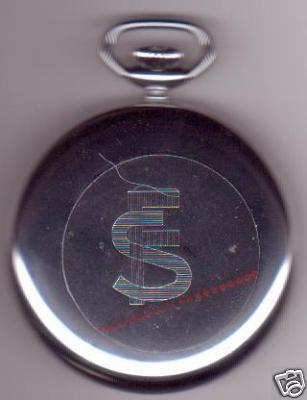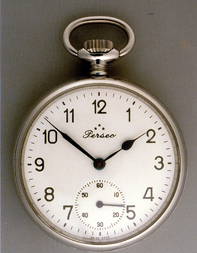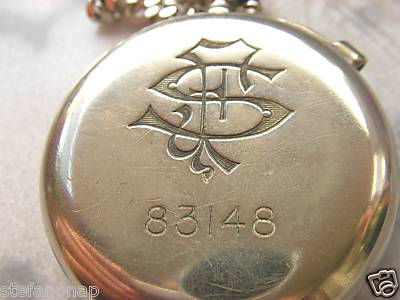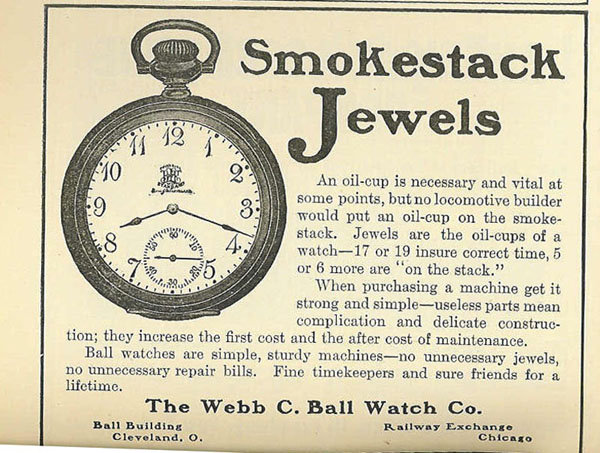
| WWT Shows | CLICK TO: Join and Support Internet Horology Club 185™ | IHC185™ Forums |

|
• Check Out Our... • • TWO Book Offer! • |
Welcome Aboard IHC185™  Internet Horology Club 185
Internet Horology Club 185  IHC185™ Discussion Site Main Page
IHC185™ Discussion Site Main Page  Horological Discussions, Questions and Answers
Horological Discussions, Questions and Answers  Military Timepiece Discussions - EXCLUSIVE!
Military Timepiece Discussions - EXCLUSIVE!  Zenith 16s 15J Military?
Zenith 16s 15J Military?
 Internet Horology Club 185
Internet Horology Club 185  IHC185™ Discussion Site Main Page
IHC185™ Discussion Site Main Page  Horological Discussions, Questions and Answers
Horological Discussions, Questions and Answers  Military Timepiece Discussions - EXCLUSIVE!
Military Timepiece Discussions - EXCLUSIVE!  Zenith 16s 15J Military?
Zenith 16s 15J Military?Go  | New Topic  | Find-Or-Search  | Notify  | Tools  | Reply to Post  |  |
| IHC Life Member |
For some time, I have been "shopping" for a Zenith just to "add" to my Swiss watches. I was lucky enough to get s/n 2638139 16s 15 jewel model, which I guess by the s/n is late 30's early 40's. When it arrived, I see that it appears to have some markings on the back cover that could be military, although the dial and hands are not typical military. Any thoughts what "FS 102661" are for?  | ||
|
I don't know, but a couple of thoughts are: 1: The FS or SF monogram could have been added by some later owner after the watch had gone out of government hands; or, 2: That the FS or SF might be a company or institution of some kind that had a need for pocket watches and this might not be a military watch? Is the movement inside original to the dial and the rest of the watch? The roman numerals on the dial tended to be more commonly seen on turn of the century military timepieces and not on ones of the 1930s to 1940s vintage the movement serial number suggests, though of course anything is possible. Also, the "Grand Prix Paris 1900" marking on the dust cover suggests to me that the case may be more likely to be a turn of the century age rather than the era of the movement. It is curious and I look forward to hearing other's thoughts. | ||||
|
| IHC Life Member |
Thanks for the observations Jim, I was thinking maybe "Securitie Francois" or however the French say that. As for the movement, I have no idea what the real age is. I was estimating from Shugart's note that by 1920 Zenith had made 2,000,000 watches. However that means little as for the actual serial numbers used. It could be early 1900's. While the watch needs cleaning it does keep good time. I think it's lubricated by nicotine! More thoughts Anybody? | |||
|
Nice find David, Zenith's in good condition are always very sought after by collectors and make good prices! I'm not sure the engraved initials would stand for 'Sécurité Française' though. A quick 'Google' throws up too many possibilities really. The initials appear a bit too 'flowery' for any Governmental office too to be honest. I think I'd go along with Jim on his suggestion they were added afterwards, the watch being sold out of some service or other. But, the watch could well have been issued to a serving officer in the armed forces who stuck his initials on it! The watch itself being pin set, I'd put somehwere between 1900 (the 'Grand Prix Date) and maybe to 1920ish when stem wind/set were more usual. There are always exceptions with Swiss watches though, but I wouldn't put it a deal later! Just to add a point about the Roman numerals, if you check my 'H. White' (English Freesprung) military watch topic, that watch is also pin set, hallmarked 1912, and has Roman numerals. John | ||||
|
It is a nice pocket watch but not military. The meaning of FS engraving is "Ferrovie dello Stato", the Italian railways. Hope it helps. Best regards, Aldo. | ||||
|
Thanks Aldo! That would fit with my second guess that it was bought by some organization or company that needed a number of pocket watches. While it is not a military watch, it is a railroad watch which I think is just as interesting. | ||||
|
| IHC Life Member |
Aldo, the serial number places this about 1935 - 1939, could this be during Mussolini's reign? | |||
|
A serial 95xxx belongs to the end of thirties, so yours is correct to say it was pre-war issued. In those years, 20ies and 30ies, there were Longines and Zenith with the same type dial and engraving, later Perseo Pocket watches were also issued, Cortebert movements. Best regards,Aldo. | ||||
|
| Railway Historian IHC Life Member Site Moderator |
Due to shortages of timepieces during the war, many prewar watches were placed in service. It could be possible that the military ordnance markings were added during the war. | |||
|
There are no military ordinance markings on this watch. They are Italian railroad company markings. | ||||
|
| Railway Historian IHC Life Member Site Moderator |
If this is an Italian railway grade watch they used during the 1930s, their standards couldn't have been very high. | |||
|
here is a picture from Ebay of 1970's "Perseo' the official watch for the Ferrovie dello Stato (Italian Railway) where you can see a similiar FS mark. Now,I do not know (even if i am Italian) the railroad requirements during the 1930's. When the fascism went in to power in Italy many"foreign" English or French words had to disappear to not "mix" the pure Italian language.For example words as "chewing gun or football" were words not to say. Historic watch makers as Patek Philippe or Longines had real troubles to marketing their names in Italy during the Fascism,not having names so called 'Italici' (italians).That is why PERSEO has been chosen as ideal manufacture for the Ferrovie dello Stato,remember the Italian Railways belong to the State and during the 1930's consequently to the Fascist Regime. Andrea  | ||||
|
dial..  | ||||
|
Here more interesting news.. "The period from 1922 to 1939 was heavy with important construction and modernisation programmes for the Italian railways, which incorporated also 400 km (249 miles) from the Ferrovie Reali Sarde of Sardinia. The most important programme was that of the direttissime Rome-Naples and Bologna-Florence: the first reduced the travel time from the two cities by an hour and a half; the second, announced proudly as "constructing Fascism", included the longest gallery of the world. Electrification on 3,000 V direct current was introduced, which later supplanted the existing three-phase system. Other improvements included automatic blocks, light signals, construction of numerous main stations (Milano Centrale, Napoli Mergellina, Roma Ostiense and others) and other technical updates. The rolling stock was enhanced from 1933 by DMU and EMU, nicknamed Littorine from the lictorial symbols of the Fascist regime. The Italian EMUs (elettrotreni), in particular, started the traditional vanguard position of Italy in the field: on December 6, 1937 an ETR 200 travelled on the Rome-Naples at a speed of 201 km/h (125 mph) in the Campoleone-Cisterna section[1] Two years later the same train reached 203 km/h (126 mph) on the Milan-Florence. In this period also began the traditional service of treni derrate (food trains) in refrigerated wagons from southern to northern Italy, and abroad as well. In 1928 the first direct connections between Naples-Rome-Turin and Milan were completed. In this period the popular motto durante il Fascismo i treni arrivavano in orario ("during Fascism the trains arrived on time") became widespread. This was due to several factors: the still uncrowded lines, the updated stock, but also to the severe discipline to which the engine-drivers were subjected; in particular, they had to pay personally for the delays of the trains they drove. The Ferrovie dello Stato were moved from the Ministry of Public Works to the newly formed Ministry of Transports." | ||||
|
..and here a Longines for Ferrovie dello Stato,Italian Railway.(taken from Ebay) Andrea  | ||||
|
Interesting this Longines, with the case lugs to be sealed by wire and lead, a stationmaster watch. Aldo. | ||||
|
| Railway Historian IHC Life Member Site Moderator |
Hello Aldo and Andrea: Interesting watch case, and Italian State Railway History, I would suspect that the pocket watch case was sealed by the watchmaker, or some other official, so the employee required to carry the pocketwatch could not tamper with the regulator. This was an important rule on North American railways, that employees were not allowed to regulate their pocket watches. | |||
|
While I am not a railroad watch guy, I have noticed that American railroad watches seem to be quite high quality while many of their European counterparts tend to not be at quite the same level. Perhaps there were more rules and regulations about what was an acceptable pocketwatch for railroad use in the U.S. than many other countries? Are there any railroad watch guys around here who might provide some information on this? | ||||
|
| Life Achievement Military Expert |
Generally, I would have to agree with Jim. The European RR watches do tend to be more utilitarian. I have not seen more than 15 to 17 jewels. However, when issued, they may have been sufficiently accurate for the job. Consider that in the early 1890's 15 jewels was still an excellent RR watch in the U.S. As for watches used by European RR's, couple of Longines watches were rather interesting. One was used by a Swiss railroad and it was in a lockable case. The other Longines was used by the Imperial Russian Rail Road. It had gold escapement parts, which might have been present to avoid magnatism. I would not call these watches cheap, but they were not up to Ball standards either. Best regards, Greg | |||
|
| IHC Life Member |
Consider the practical use of watches in europe at that time was usually limited to one time zone in each country, the topography of europe was hardly a high speed rail thing until Hitler introduced straight-line traffic at all costs to get his war stuff moving. Also the RR's were stopped at the borders anyway, so it was what by our standards would be called a "local service" that required less stringent timing in the first place. As for the watches, Mr. Ball himself declared 17 jewels was enough for any good RR watch, and many of us still agree with him, includiung most europewan watchmakers. I am amazed that we continue to succor ourselves with the 1, 2, 3 and sometimes 3-1/2 pairs of cap jeweling of a 17 jewel movment that only raises the time spent to clean a good watch without contributing anything to it's time accuracy. (OExcepting the 19 Jewel movements that have a properly Jeweled motor barrel.)  | |||
|
| Powered by Social Strata |
| Your request is being processed... |
|
©2002-2025 Internet Horology Club 185™ - Lindell V. Riddle President - All Rights Reserved Worldwide

